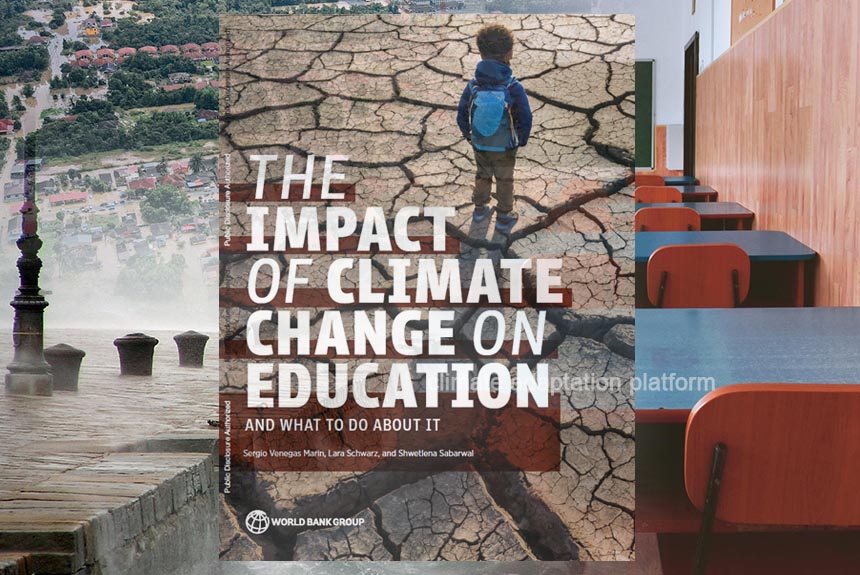Extreme weather events close schools and effectively disrupt education. Climate change is increasing the intensity and frequency of these extreme natural events, such as heatwaves, stronger storms, floods, and wildfires. In developing countries, education is a way out of poverty, but governments must protect it against the detrimental effects of climate change.
A World Bank Group report, “The Impact of Climate Change on Education,” released in April 2024, discusses the impacts of extreme natural events on children’s education and health, which can further erode education outcomes. Climate change’s adverse impacts on education will have long-term effects on the economy.
The report notes that “A 10-year-old in 2024 will experience twice as many wildfires and tropical cyclones, three times more river floods, four times more crop failures, and five times more droughts over her lifetime in a 3°C global warming pathway than a 10-year-old in 1970. Over the past 20 years, schools were closed in around 75 per cent or more of the extreme weather events that impacted 5 million people or more. These closures were often prolonged due to infrastructure vulnerability and the use of school infrastructure for emergency sheltering. Rigorous evidence from COVID-19 shows that, on average, a day of school closures is a day of learning loss.”
The report presents the impacts of extreme events on children’s education, such as high temperatures, intense heat waves, and stronger storms.
For example, a hot day inside the classroom inhibits learning. Temperatures that deviate significantly from local trends result in learning losses, and these small learning losses from temperatures increasing accumulate over time and translate into significant losses in income, lowered productivity, greater inequality and possibly increased social unrest.
Cold weather can also disrupt schooling and learning. Cold snaps and storms can produce property damage and power failures, affecting infrastructure and educational systems. An example is the January and February 2024 winter storms that caused school closures in central and eastern Europe and the midwestern United States.
Drought in 2015 in Malawi closed 42% of primary schools, forcing over 130,000 boys and girls to drop out. Cyclones in 2009 and 2013 damaged 4,300 and 19,300 schools, respectively, in the Philippines, leading to extended school closures. As the incidence of extreme weather events continues to increase, so does the likelihood of these school closures.
School closures are prolonged when school infrastructure is vulnerable or used as evacuation centres, as in the case of the school buildings in Samoa, Tonga, and Vanuatu.
The report notes that the low-to-middle-income countries (LMICs), home to 85% of the world’s children, will bear the severe impacts of climate change.
Despite climate change’s disastrous consequences, education remains overlooked. According to the report, education comprised less than 1.3% of climate-related official development assistance in 2020 and was mentioned in less than 1 in 3 nationally determined contribution plans.
The report lays out four concrete ways in which policymakers can adapt the education systems for greater climate resilience:
- Education management for resilience consists of planning for adaption and risk management with data, establishing early warning systems, and strengthening school-level management.
- School infrastructure for resilience – ensuring compliance with building codes, implementing structural adjustments to minimise damage, providing a risk-informed location for new schools away from climate hazards, and managing classroom temperatures.
- Ensuring learning continuity in the face of climate shocks: keeping schools open to the extent possible, and every effort should be made to reopen as soon as possible. Minimising the time schools are exclusively used as emergency shelters, establishing remote learning programmes, and ensuring attendance and catch-up after schools reopen.
- Leveraging students and teachers as agents for change and resilience by involving students and teaching in risk management, equipping teachers with training and tools, and supporting students and teachers after climate shocks.
However, this adaptation requires policymakers to allocate sufficient funding to boost climate resilience within the education sector. Effectively implementing adaptation strategies to minimise harm and cope with climate shocks will require additional funds for the education sector.
The impact of climate change on education is profound and multifaceted. Addressing these challenges requires a comprehensive approach that includes strengthening infrastructure, ensuring health and safety, providing economic support, accommodating displaced students, developing relevant curricula, and engaging communities.
By taking proactive measures, governments and policymakers can mitigate the adverse effects of climate change on education and ensure that future generations are well-equipped to face and combat these challenges.
You can download and read the full report by browsing the link in the “Source” section below.
Source:
The Impact of Climate Change on Education and what to do about it. (2024, May 3). Reliefweb. Retrieved from https://reliefweb.int/report/world/impact-climate-change-education-and-what-do-about-it
Marin, S., Schwarz, L., & Sabarwal, S., (2024 April). The Impact of Climate Change On Education And What To Do About It. World Bank Group. Retrieved from https://reliefweb.int/attachments/c8f87fac-29b5-4af9-9250-034f3cafd65e/WB%20Climate%20change%20Education%202024.04.30.pdf



Leave a Reply